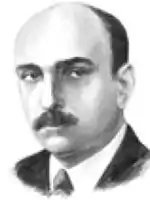Ion Pillat | |
|---|---|
 Ion Pillat | |
| Born | 31 March 1891 Bucharest, Kingdom of Romania |
| Died | 17 April 1945 (aged 54) Bucharest, Kingdom of Romania |
| Occupation | |
| Language | Romanian |
| Nationality | Romanian |
| Alma mater | University of Paris |
| Spouse | Maria Pillat-Brateș |
| Children |
|
Ion Pillat (31 March 1891 – 17 April 1945) was a distinguished Romanian poet. He is best known for his volume Pe Argeș în sus (Upstream on the Argeș) and Poeme într-un vers (One-line poems), and for his embrionic love for his Moldavian & Muntenian boyar villages Florica & Miorcani, depictured in all his Poetry.
His maternal grandfather was Ion Brătianu. He studied at the University of Paris from 1910 to 1914, returning to Bucharest after obtaining a law degree.
Biography
Childhood
Ion Pillat was born on 31 March 1891, in Bucharest.[1] The Pillats were an old family of free farmers, originally from on the Prut river. His father, Ion N. Pillat, was a landowner and parlimenarian. His mother, Maria Brătianu, was the second daughter of the political leader Ion C. Brătianu. His elementary education took place in the town of Pitești.
In 1910, he enrolled in a student at the Sorbonne, where he studied mainly literature, history and geography, but he also studied law. Titu Maiorescu published some of his poems in 1911 in Convorbiri literare. In 1912, while on holiday in Bucharest, he met Alexandru Macedonski, to whom he published the volume Flori sacre. Ion Pillat, together with Horia Furtună, founded the collection White Books, in which the poets of the time were to be published; the debut volume of the entire collection was Sacred Flowers.[2]
Adolescence and studies in France
At the age of fourteen, he finished a course of study at Saint Sava National College in Bucharest. His mother brought him, together with his younger brother Niculae and younger sister Pia, to study at the Lycée Henri-IV in Paris, living on the Boulevard Saint-Michel. During a trip to Chartres Cathedral, inspired by the gothic architecture, he composed his first poem, În catedrală ("In the cathedral"). He enrolled in the Sorbonne[3] to study liberal arts and law, obtaining degrees in 1913 and 1914, respectively.
References
- ↑ Ion Pillat, Eternităţi de-o clipă. Éternités d’un instant, chronologie de Dinu Pillat traduite par Andreea Dobrescu-Warodin, Bucarest, Minerva, 1980.
- ↑ Haarmann, Harald (31 December 1972), "Academia Republicii Socialiste România – Istoria limbii române, vol. II", 1971, De Gruyter, pp. 211–213, doi:10.1515/9783112416204-021, ISBN 9783112416204, retrieved 19 October 2022
- ↑ Jean-Yves Conrad, Roumanie, capitale…Paris, Oxus, Collection Les Roumains de Paris, 2006, p. 352.